
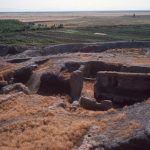 Çatalhöyük: The First Town of the Neolithic Age - Lying on the Konya plain in the south of modern day Turkey, Çatalhöyük is the world’s earliest known town. Founded roughly 9500 years ago, the settlement covered 35 acres — making it larger than the ancient city of Jericho, founded some 500 years later. Archaeological evidence unearthed at Çatalhöyük suggests that the town’s 5000 to 8000 residents lived in a society with no class system or gender barriers. They subsisted on cereal farming, the raising of livestock and, most importantly, the trading in black obsidian mined from the mountain Hasan Dag, located 87 miles to the east. Most interesting still was the town’s configuration. All homes in Çatalhöyük were built from sun-dried brick and entered through the roof. There were no streets, alleyways or plazas in the town — each house was built wall-to-wall to its neighbor. The result was a large cube, and eventually a mound, whose outer most…
Çatalhöyük: The First Town of the Neolithic Age - Lying on the Konya plain in the south of modern day Turkey, Çatalhöyük is the world’s earliest known town. Founded roughly 9500 years ago, the settlement covered 35 acres — making it larger than the ancient city of Jericho, founded some 500 years later. Archaeological evidence unearthed at Çatalhöyük suggests that the town’s 5000 to 8000 residents lived in a society with no class system or gender barriers. They subsisted on cereal farming, the raising of livestock and, most importantly, the trading in black obsidian mined from the mountain Hasan Dag, located 87 miles to the east. Most interesting still was the town’s configuration. All homes in Çatalhöyük were built from sun-dried brick and entered through the roof. There were no streets, alleyways or plazas in the town — each house was built wall-to-wall to its neighbor. The result was a large cube, and eventually a mound, whose outer most…  Ancient Egyptian Hair Fashion - Hairstyles throughout the history of civilization have been as much a part of the costume and fashion of a given culture as clothing and offer insight to curious aesthetic choices of different regions. More than three thousand years ago the men, women and children of ancient Egypt embellished their looks with wigs in different styles. Early examples of wigs, found in excavations of Egyptian tombs, reveal that they were made of animal hair or vegetable fiber curled or braided and adhered to mesh caps to be worn for both ceremonial or everyday purposes. Subsequently, wigs were made of human hair and often interlaced with ribbons or flowers and further decorated with gold and precious stones. Not everyone wore wigs, although they were prevalent, but similar hair styles were applied to both natural hairdos and wigs. Plaiting was very popular: hair would be woven in fine braids or curled or crimped…
Ancient Egyptian Hair Fashion - Hairstyles throughout the history of civilization have been as much a part of the costume and fashion of a given culture as clothing and offer insight to curious aesthetic choices of different regions. More than three thousand years ago the men, women and children of ancient Egypt embellished their looks with wigs in different styles. Early examples of wigs, found in excavations of Egyptian tombs, reveal that they were made of animal hair or vegetable fiber curled or braided and adhered to mesh caps to be worn for both ceremonial or everyday purposes. Subsequently, wigs were made of human hair and often interlaced with ribbons or flowers and further decorated with gold and precious stones. Not everyone wore wigs, although they were prevalent, but similar hair styles were applied to both natural hairdos and wigs. Plaiting was very popular: hair would be woven in fine braids or curled or crimped…  Ancient Egypt and the Fertile Nile River - The Ancient Egyptians developed their civilization sometime between 4000 and 1800 B.C. along the fertile Nile River. The annual floods of the Nile deposited rich soil along its banks and helped establish Egypt as a green oasis in an unforgiving desert. Since the welfare of the Ancient Egyptians depended almost entirely on the Nile an intricate relationship grew between man and the river that sustained them. The Egyptians cultivated the land along the Nile River’s banks and grew essential crops to help sustain their way of life. Their farming endeavors yielded the wheat and barley used for bread and beer and the flax they utilized for their linen. Over time, the Ancient Egyptian’s concept of religion became highly developed and they also advanced their knowledge in medicine, astronomy and engineering, all of which would serve as examples to many societies that followed in their footsteps.
Ancient Egypt and the Fertile Nile River - The Ancient Egyptians developed their civilization sometime between 4000 and 1800 B.C. along the fertile Nile River. The annual floods of the Nile deposited rich soil along its banks and helped establish Egypt as a green oasis in an unforgiving desert. Since the welfare of the Ancient Egyptians depended almost entirely on the Nile an intricate relationship grew between man and the river that sustained them. The Egyptians cultivated the land along the Nile River’s banks and grew essential crops to help sustain their way of life. Their farming endeavors yielded the wheat and barley used for bread and beer and the flax they utilized for their linen. Over time, the Ancient Egyptian’s concept of religion became highly developed and they also advanced their knowledge in medicine, astronomy and engineering, all of which would serve as examples to many societies that followed in their footsteps.  History of Megalithic Europe - Sometime between 4500 and 1200 B.C. an ancient civilization created large megalithic monuments in the regions that today form the countries of Spain, France, Ireland, Britain and Sweden. Archaeologists believe the civilizations that built these megalithic structures throughout Western Europe may have developed farming around 4500 B.C. Several centuries later, the first megaliths were built in Brittany and Ireland in approximately 4300 B.C., followed by the building of more elaborate megalithic structures in the centuries that followed. The most famous of these megalithic monuments are Stonehenge, the Ring of Brodgar and Stoney Littleton.
History of Megalithic Europe - Sometime between 4500 and 1200 B.C. an ancient civilization created large megalithic monuments in the regions that today form the countries of Spain, France, Ireland, Britain and Sweden. Archaeologists believe the civilizations that built these megalithic structures throughout Western Europe may have developed farming around 4500 B.C. Several centuries later, the first megaliths were built in Brittany and Ireland in approximately 4300 B.C., followed by the building of more elaborate megalithic structures in the centuries that followed. The most famous of these megalithic monuments are Stonehenge, the Ring of Brodgar and Stoney Littleton. 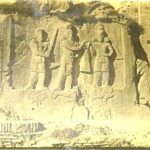 Mesopotamia – Sumer, Akkad, and Ur - More than 7,000 years ago, the Sumerians built several independent city states and the first civilization known to man in an area within the Fertile Crescent known as Mesopotamia. As commerce expanded in Mesopotamia, important Sumerian cities emerged across the network of trade routes along the fertile Tigris and Euphrates River valleys. These growing cities attracted a diverse group of traders who traveled from Egypt to India and brought with them a variety of exotic wares and skills from their journey. The Sumerians adapted to the challenges introduced with the increased trade activity by establishing well organized cities, some of which would last for 3,000 years.
Mesopotamia – Sumer, Akkad, and Ur - More than 7,000 years ago, the Sumerians built several independent city states and the first civilization known to man in an area within the Fertile Crescent known as Mesopotamia. As commerce expanded in Mesopotamia, important Sumerian cities emerged across the network of trade routes along the fertile Tigris and Euphrates River valleys. These growing cities attracted a diverse group of traders who traveled from Egypt to India and brought with them a variety of exotic wares and skills from their journey. The Sumerians adapted to the challenges introduced with the increased trade activity by establishing well organized cities, some of which would last for 3,000 years. 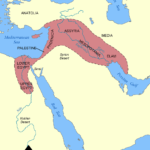 The Fertile Crescent and First Farmers - The first farmers settled in the Fertile Crescent along the Euphrates and Tigris river valleys (an area covered by present day Iraq, Syria and Azerbaijan) around 10,000 B.C. The favorable climate and topography of this region permitted the Cro-Magnons and their progeny to experiment in agriculture by growing staple crops like wheat and barley, which they used to make bread, an essential part of the diet of every early civilization. These agriculture based communities represented a fundamental shift in the mindset of early humans. Where in the past early humans had followed their food as hunter gatherers, now, they discovered a means to sustain themselves by manipulating the natural resources and animal life in their immediate environment. Soon semi-permanent communities evolved from these farming communities, bringing with them more innovations, including the domestication of animals and irrigation techniques which assisted them in their cultivation of plants for crops.
The Fertile Crescent and First Farmers - The first farmers settled in the Fertile Crescent along the Euphrates and Tigris river valleys (an area covered by present day Iraq, Syria and Azerbaijan) around 10,000 B.C. The favorable climate and topography of this region permitted the Cro-Magnons and their progeny to experiment in agriculture by growing staple crops like wheat and barley, which they used to make bread, an essential part of the diet of every early civilization. These agriculture based communities represented a fundamental shift in the mindset of early humans. Where in the past early humans had followed their food as hunter gatherers, now, they discovered a means to sustain themselves by manipulating the natural resources and animal life in their immediate environment. Soon semi-permanent communities evolved from these farming communities, bringing with them more innovations, including the domestication of animals and irrigation techniques which assisted them in their cultivation of plants for crops. Family History: April, 28, 2024
Family Births
- On 1424-04-28, Elizabeth WINGFIELD is born in Suffolk, Orford, England
- On 1700-04-28, Susanna Page CHILES is born in King William County, Virginia, USA
- On 1895-04-28, Benjamin Franklin POWERS is born in Wake Forest, Wake, North Carolina, USA
Family Deaths
- On 1807-04-28, Daniel Anderson ALLEN dies in Cumberland County, VA
- On 1808-04-28, Abraham WARWICK dies in Amherst, Virginia, United States
- On 1814-04-28, Nancy Ann CORN dies in Tennessee, Patrick, Virginia, United States
- On 1908-04-28, Walter Reaves GRIGGS dies in Henry Co., VA
- On 1971-04-28, Helen Virginia FONVIELLE dies in Durham, Durham, North Carolina, USA
- On 1990-04-28, Clarence OSTERBUHR dies in Garden City, Finney County, Kansas, United States of America
| Paternal Line | Maternal Line | ||
|---|---|---|---|
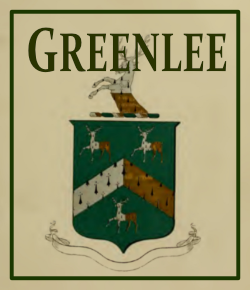 |
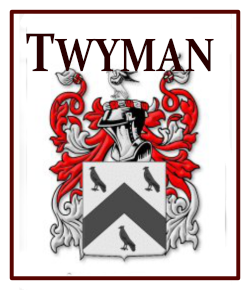 |
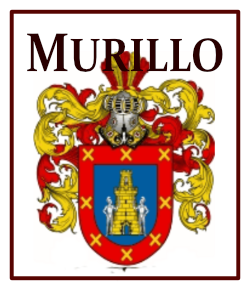 |
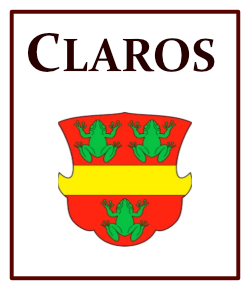 |
Categories
Genealogy
- Genealogy Portal
-
Search genealogical information related to the Greenlee, Murillo, Twyman and Claros families. Please contact us if you think we're related and can help each other in expanding our ancestry trees.
